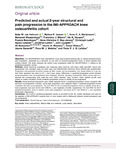Predicted and actual 2-year structural and pain progression in the IMI-APPROACH knee osteoarthritis cohort

Ver/
Use este enlace para citar
http://hdl.handle.net/2183/32411
A non ser que se indique outra cousa, a licenza do ítem descríbese como Atribución-NoComercial-SinDerivadas 3.0 España
Coleccións
- Investigación (FFISIO) [503]
Metadatos
Mostrar o rexistro completo do ítemTítulo
Predicted and actual 2-year structural and pain progression in the IMI-APPROACH knee osteoarthritis cohortAutor(es)
Data
2023-01Cita bibliográfica
van Helvoort EM, Jansen MP, Marijnissen ACA, Kloppenburg M, Blanco FJ, Haugen IK, Berenbaum F, Bay-Jensen AC, Ladel C, Lalande A, Larkin J, Loughlin J, Mobasheri A, Weinans HH, Widera P, Bacardit J, Welsing PMJ, Lafeber FPJG. Predicted and actual 2-year structural and pain progression in the IMI-APPROACH knee osteoarthritis cohort. Rheumatology (Oxford). 2022 Dec 23;62(1):147-157.
Resumo
[Abstract] Objectives: The IMI-APPROACH knee osteoarthritis study used machine learning (ML) to predict structural and/or pain progression, expressed by a structural (S) and pain (P) predicted-progression score, to select patients from existing cohorts. This study evaluates the actual 2-year progression within the IMI-APPROACH, in relation to the predicted-progression scores.
Methods: Actual structural progression was measured using minimum joint space width (minJSW). Actual pain (progression) was evaluated using the Knee injury and Osteoarthritis Outcomes Score (KOOS) pain questionnaire. Progression was presented as actual change (Δ) after 2 years, and as progression over 2 years based on a per patient fitted regression line using 0, 0.5, 1 and 2-year values. Differences in predicted-progression scores between actual progressors and non-progressors were evaluated. Receiver operating characteristic (ROC) curves were constructed and corresponding area under the curve (AUC) reported. Using Youden's index, optimal cut-offs were chosen to enable evaluation of both predicted-progression scores to identify actual progressors.
Results: Actual structural progressors were initially assigned higher S predicted-progression scores compared with structural non-progressors. Likewise, actual pain progressors were assigned higher P predicted-progression scores compared with pain non-progressors. The AUC-ROC for the S predicted-progression score to identify actual structural progressors was poor (0.612 and 0.599 for Δ and regression minJSW, respectively). The AUC-ROC for the P predicted-progression score to identify actual pain progressors were good (0.817 and 0.830 for Δ and regression KOOS pain, respectively).
Conclusion: The S and P predicted-progression scores as provided by the ML models developed and used for the selection of IMI-APPROACH patients were to some degree able to distinguish between actual progressors and non-progressors.
Palabras chave
Knee osteoarthritis
Biomarkers
Clinical trials and methods
Study design
Biomarkers
Clinical trials and methods
Study design
Descrición
ClinicalTrials.gov, https://clinicaltrials.gov, NCT03883568
Versión do editor
Dereitos
Atribución-NoComercial-SinDerivadas 3.0 España
ISSN
1462-0324






